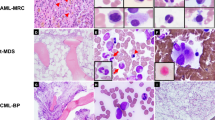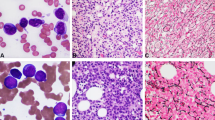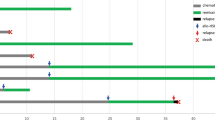Abstract
Patients with myeloid malignancies and either the 3q21q26 syndrome or t(1;3)(p36;q21) have been reported to share similar clinicopathological features and a common molecular mechanism for leukemogenesis. Overexpression of MDS1/EVI1 (3q26) or MEL1/PRDM16 (1p36), both members of the PR-domain family, has been directly implicated in the malignant transformation of this subset of neoplasias. The breakpoints in both entities are outside the genes, and the 3q21 region, where RPN1 is located, seems to act as an enhancer. MEL1 has been reported to be expressed in leukemia cells with t(1;3) and in the normal uterus and fetal kidney, but neither in bone marrow (BM) nor in other tissues, suggesting that this gene is specific to t(1;3)-positive MDS/AML. We report the molecular characterization of a t(1;3)(p36;q21) in a patient with MDS (RAEB-2). In contrast to previous studies, we demonstrate that MEL1, the PR-containing form, and MEL1S, the PR-lacking form, are widely expressed in normal tissues, including BM. The clinicopathological features and the breakpoint on 1p36 are different from cases previously described, and MEL1 is not overexpressed, suggesting a heterogeneity in myeloid neoplasias with t(1;3).
This is a preview of subscription content, access via your institution
Access options
Subscribe to this journal
Receive 50 print issues and online access
$259.00 per year
only $5.18 per issue
Buy this article
- Purchase on Springer Link
- Instant access to full article PDF
Prices may be subject to local taxes which are calculated during checkout



Similar content being viewed by others
References
Barjesteh van Waalwijk van Doorn-Khosrovani S, Erpelinck C, van Putten WL, Valk PJ, van der Poel-van de Luytgaarde S, Hack R, Slater R, Smit EM, Beverloo HB, Verhoef G, Verdonck LF, Ossenkoppele GJ, Sonneveld P, de Greef GE, Lowenberg B and Delwel R . (2003). Blood, 101, 837–845.
Du Y, Carling T, Fang W, Piao Z, Sheu JC and Huang S . (2001). Cancer Res., 61, 8094–8099.
Fichelson S, Dreyfus F, Berger R, Melle J, Bastard C, Miclea JM and Gisselbrecht S . (1992). Leukemia, 6, 93–99.
Huang S . (1999). Front Biosci., 4, D528–532.
Huang S . (2002). Nat. Rev. Cancer, 2, 469–476.
Langabeer SE, Rogers JR, Harrison G, Wheatley K, Walker H, Bain BJ, Burnett AK, Goldstone AH, Linch DC and Grimwade D . (2001). Br. J. Haematol., 112, 208–211.
Mochizuki N, Shimizu S, Nagasawa T, Tanaka H, Taniwaki M, Yokota J and Morishita K . (2000). Blood, 96, 3209–3214.
Morishita K, Parganas E, William CL, Whittaker MH, Drabkin H, Oval J, Taetle R, Valentine MB and Ihle JN . (1992). Proc. Natl. Acad. Sci. USA, 89, 3937–3941.
Nishikata I, Sasaki H, Iga M, Tateno Y, Imayoshi S, Asoh N, Nakamura T and Morishita K . (2003). Blood, 102, 3323–3332.
Odero MD, Carlson K, Calasanz MJ, Lahortiga I, Chinwalla V and Rowley JD . (2001). Genes Chromosom. Cancer, 31, 134–142.
Pekarsky Y, Rynditch A, Wieser R, Fonatsch C, Gardiner K and Schnittger S . (1997). Cancer Res., 57, 3914–3919.
Rynditch A, Pekarsky Y, Schnittger S and Gardiner K . (1997). Gene, 193, 49–57.
Schneider R, Bannister AJ and Kouzarides T . (2002). Trends Biochem. Sci., 27, 396–402.
Secker-Walker LM, Mehta A and Bain B . (1995). Br. J. Haematol., 91, 490–501.
Shimizu S, Suzukawa K, Kodera T, Nagasawa T, Abe T, Taniwaki M, Yagasaki F, Tanaka H, Fujisawa S, Johansson B, Ahlgren T, Yokota J and Morishita K . (2000). Genes Chromosom. Cancer, 27, 229–238.
Soderholm J, Kobayashi H, Mathieu C, Rowley JD and Nucifora G . (1997). Leukemia, 11, 352–358.
Vinatzer U, Mannhalter C, Mitterbauer M, Gruener H, Greinix H, Schmidt HH, Fonatsch C and Wieser R . (2003). Genes Chromosom. Cancer, 36, 80–89.
Wieser R . (2002). Leuk. Lymphoma, 43, 59–65.
Xinh PT, Tri NK, Nagao H, Nakazato H, Taketazu F, Fujisawa S, Yagasaki F, Chen YZ, Hayashi Y, Toyoda A, Hattori M, Sakaki Y, Tokunaga K and Sato Y . (2003). Genes Chromosom. Cancer, 36, 313–317.
Acknowledgements
We thank Itziar Olabarria for providing clinical data. This work was supported by the Departamento de Salud del Gobierno de Navarra, Ministerio de Sanidad (FIS 01/0133), RTIC Cancer C10/03 (FIS) (Spain) and by the Associazione Italiana per la Ricerca sul Cancro (Italy).
Author information
Authors and Affiliations
Corresponding author
Rights and permissions
About this article
Cite this article
Lahortiga, I., Agirre, X., Belloni, E. et al. Molecular characterization of a t(1;3)(p36;q21) in a patient with MDS. MEL1 is widely expressed in normal tissues, including bone marrow, and it is not overexpressed in the t(1;3) cells. Oncogene 23, 311–316 (2004). https://doi.org/10.1038/sj.onc.1206923
Received:
Revised:
Accepted:
Published:
Issue Date:
DOI: https://doi.org/10.1038/sj.onc.1206923
Keywords
This article is cited by
-
Acute myeloid leukemia with rare recurring translocations—an overview of the entities included in the international consensus classification
Annals of Hematology (2024)
-
Differential epigenetic regulation between the alternative promoters, PRDM1α and PRDM1β, of the tumour suppressor gene PRDM1 in human multiple myeloma cells
Scientific Reports (2020)
-
FISH analysis of hematological neoplasias with 1p36 rearrangements allows the definition of a cluster of 2.5�Mb included in the minimal region deleted in 1p36 deletion syndrome
Human Genetics (2005)



